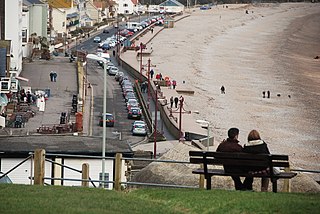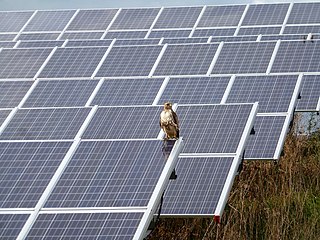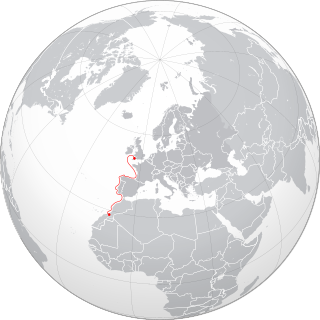
Seaton is a seaside town, fishing harbour and civil parish in East Devon on the south coast of England, between Axmouth and Beer. It faces onto Lyme Bay and is on the Jurassic Coast, a World Heritage Site. A sea wall provides access to the mostly shingle beach stretching for about a mile, and a small harbour on the River Axe estuary.

Solar power is a major contributor to electricity supply in Australia. As of December 2023, Australia's over 3.69 million solar PV installations had a combined capacity of 34.2 GW photovoltaic (PV) solar power. In 2019, 59 solar PV projects with a combined capacity of 2,881 MW were either under construction, constructed or due to start construction having reached financial closure. Solar accounted for 12.4% of Australia's total electrical energy production in 2021.

Renewable energy in Australia is mainly based on biomass, solar, wind, and hydro generation. Over a third of electricity is generated from renewables, and is increasing, with a target to phase out coal power before 2040. Wind energy and rooftop solar have particularly grown since 2010. The growth has been stimulated by government energy policy in order to limit the rate of climate change in Australia that has been brought about by the use of fossil fuels. Pros and cons of various types of renewable energy are being investigated, and more recently there have been trials of green hydrogen and wave power.

India's solar power installed capacity was 84.28 GW AC as of 31 May 2024. India is the third largest producer of solar power globally.

Solar power has a small but growing role in electricity production in the United Kingdom.

Energy in Croatia describes energy and electricity production, consumption and import in Croatia.

The energy sector in Hawaii has rapidly adopted solar power due to the high costs of electricity, and good solar resources, and has one of the highest per capita rates of solar power in the United States. Hawaii's imported energy costs, mostly for imported petroleum and coal, are three to four times higher than the mainland, so Hawaii has motivation to become one of the highest users of solar energy. Hawaii was the first state in the United States to reach grid parity for photovoltaics. Its tropical location provides abundant ambient energy.

A community solar project, farm or garden is a solar power installation that accepts capital from and provides output credit and tax benefits to multiple customers, including individuals, businesses, nonprofits, and other investors. Participants typically invest in or subscribe to a certain kW capacity or kWh generation of remote electrical production. The project's power output is credited to investors or subscribers in proportion to their investment, with adjustments to reflect ongoing changes in capacity, technology, costs and electricity rates. Community solar provides direct access to the renewable energy to customers who cannot install it themselves. Companies, cooperatives, governments or non-profits operate the systems.

Solar power in Michigan has been growing in recent years due to new technological improvements, falling solar prices and a variety of regulatory actions and financial incentives. The largest solar farm in Michigan is Assembly Solar, completed in 2022, which has 347 MW of capacity. Small-scale solar provided 50% of Michigan solar electricity as recently as 2020 but multiple solar farms in the 100 MW to 200 MW range are proposed to be completed by the middle of the decade. Although among the lowest U.S. states for solar irradiance, Michigan mostly lies farther south than Germany where solar power is heavily deployed. Michigan is expected to use 120 TWh per year in 2030. To reach a 100% solar electrical grid would require 2.4% of Michigan's land area to host 108 GW of installed capacity.

Solar power in New Zealand is increasing in capacity, despite no government subsidies or interventions being available. As of the end of April 2024, New Zealand has 420 MW of grid-connected photovoltaic (PV) solar power installed, of which 146 MW (35%) was installed in the last 12 months. In the 12 months to December 2023, 372 gigawatt-hours of electricity was estimated to have been generated by grid-connected solar, 0.85% of all electricity generated in the country.
The Westlands Solar Park is large-scale solar power project in Kings County south of Fresno, California. It intends to build many photovoltaic power plants with a capacity totaling upwards of 2,000 megawatts (MW), larger than the world's largest photovoltaic power plants operating as of 2017. It will be constructed on brownfield land owned by the Westlands Water District that is unusable for agriculture due to excess salt pollution.
Edginswell railway station is a proposed station in the Edginswell area of Torquay, Devon. The station would be located on the Riviera Line between Newton Abbot and Torre stations. Edginswell will be the location of employment and housing development and the new station will support this development. The station would also serve Torbay Hospital, The Willows retail park and the Torquay Gateway development area.
The Bungala Solar Power Farm is a 220 MW solar power farm in Emeroo and Wami Kata near Port Augusta in South Australia. The first stage was connected to the grid in May 2018, and the second stage was connected to the grid in November 2018. The project gradually reached full power in 2020.
Project Fortress is a photovoltaic power station under construction on the Graveney marshes between Faversham and Whitstable, Kent in the UK.

Vineyard Wind 1 is an offshore wind farm under construction in U.S. federal waters in the Atlantic Ocean in Bureau of Ocean Energy Management-designated Lease Area OCS-A 0520, about 13 nautical miles south of Martha's Vineyard and Nantucket, Massachusetts. The array is designed to include 62 Haliade-X wind turbines manufactured by GE Offshore Wind with a nameplate capacity of 804 MW combined, equivalent to the annual power use of 400,000 homes. The Massachusetts Department of Public Utilities approved the project in 2019. Construction began on November 18, 2021. In October 2023, the first turbine was installed. Power from the first turbine started flowing into the ISO New England grid on January 2, 2024. Construction is expected to be complete by the end of 2024.

The Xlinks Morocco-UK Power Project is a proposal to create 11.5 GW of renewable generation, 22.5 GWh of battery storage and a 3.6 GW high-voltage direct current interconnector to carry solar and wind-generated electricity from the Kingdom of Morocco to the United Kingdom. Morocco has been hailed as a potential key power generator for Europe as the continent looks to reduce reliance on fossil fuels.

The Two Creeks Solar Park is a 150 MW solar photovoltaic energy station in Manitowoc County, Wisconsin. Ownership is shared between Wisconsin Public Service Corporation (WPS) and Madison Gas and Electric (MG&E), at 100 MW and 50MW, respectively. It was the first utility-scale solar plant approved and constructed in Wisconsin.
















